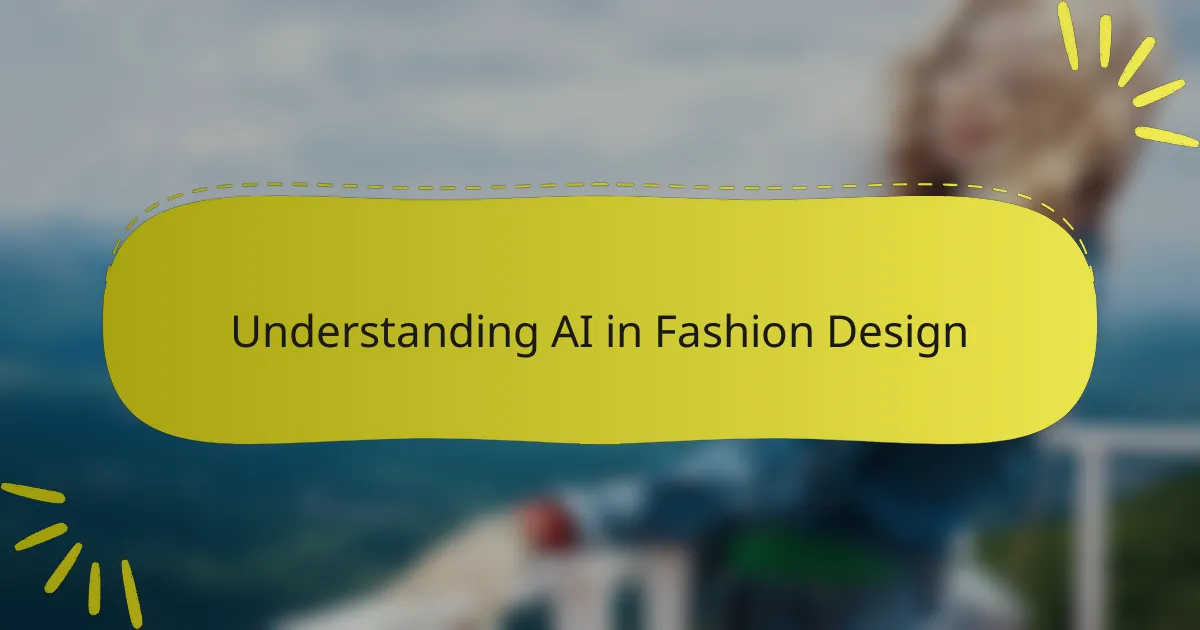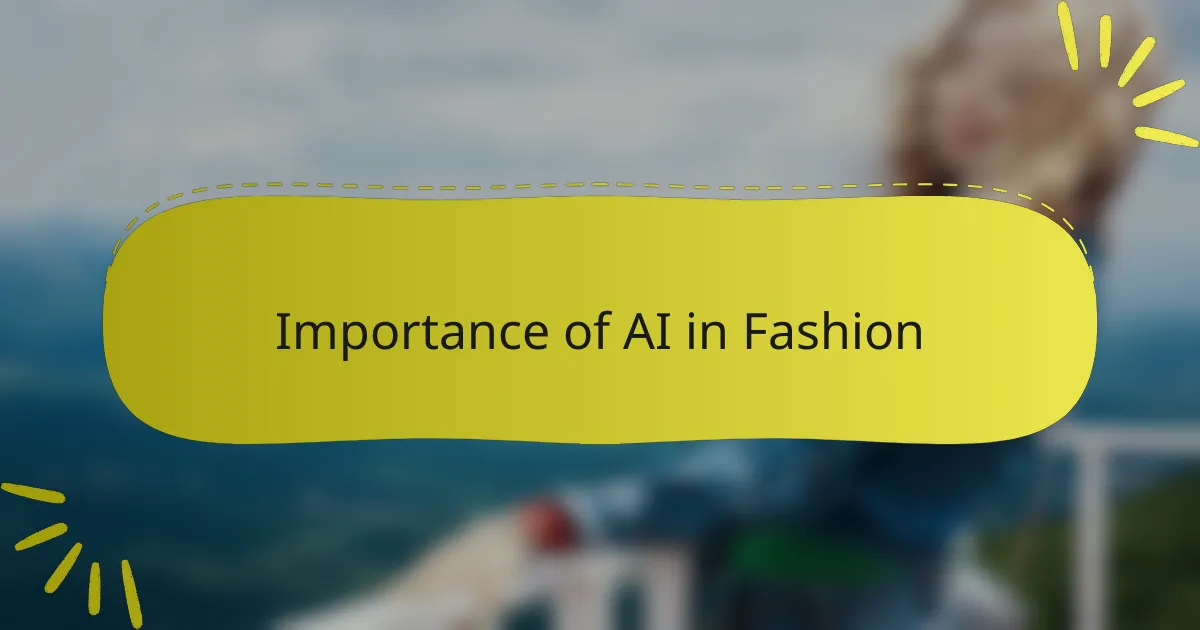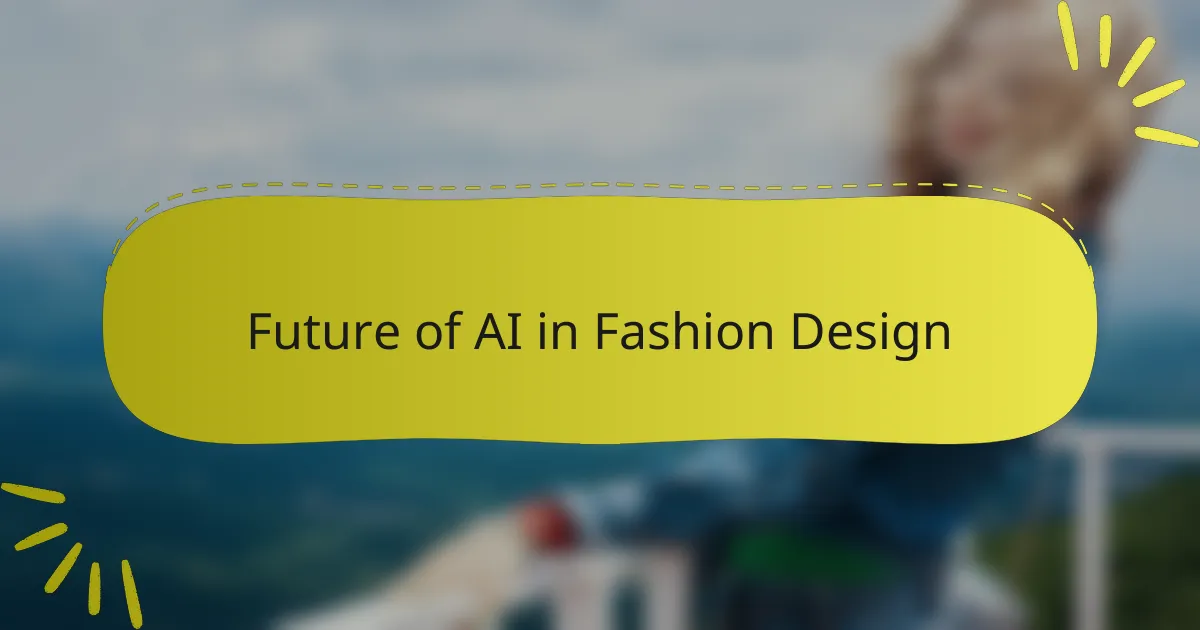Key takeaways
- AI enhances fashion design by streamlining processes, predicting trends, and enabling personalization, thereby expanding creative possibilities for designers.
- While AI offers efficiency and innovative generative design, there are concerns about the potential loss of human creativity and ethical data usage.
- Future AI developments could promote sustainability in fashion by optimizing resources and minimizing environmental impact while aligning with consumer preferences.
- Collaboration between AI and human designers could lead to unique and culturally relevant fashion that resonates on deeper emotional levels.

Understanding AI in Fashion Design
Understanding AI in Fashion Design
Artificial intelligence is transforming fashion design in remarkable ways. I recall my first encounter with AI-generated fashion concepts, and I was struck by how machines could analyze trends and create designs that were not just innovative but also visually stunning. This interplay between technology and creativity opens up a world where designers can explore ideas that push the boundaries of what’s possible.
Moreover, AI tools don’t just assist in design; they help streamline the entire fashion process. I’ve seen how they can predict consumer preferences, reduce waste in production, and facilitate a more sustainable approach to fashion. Here are some key aspects of AI’s role in this dynamic field:
- Trend Forecasting: AI analyzes social media and online platforms to predict upcoming fashion trends.
- Design Generation: AI software can generate unique designs based on inputs and parameters set by the designer.
- Personalization: AI helps create tailored collections that resonate with individual customer preferences.
- Manufacturing Efficiency: AI optimizes production processes, reducing waste and improving timelines.
- Sustainability: AI tools assist in finding sustainable materials and methods to minimize environmental impact.

Importance of AI in Fashion
AI’s importance in fashion extends beyond mere trend analysis; it revolutionizes design itself. I remember the first time I used an AI tool to create a new collection. The results were breathtaking and shocking—it felt like collaborating with a creative partner that could think outside the box. How incredible is it to witness technology imagining shapes and patterns that might never have crossed a human mind?
When it comes to personalization, AI can tailor collections that resonate deeply with consumers. I’ve often wondered how many beautifully crafted pieces go unnoticed simply because they don’t align with individual tastes. With AI’s capability to analyze vast amounts of data on customer preferences, designers can create pieces that speak directly to their audience, making fashion more inclusive and relevant.
What strikes me most is AI’s potential to drive sustainability in the fashion industry. My experience with eco-conscious initiatives has shown me how important it is to minimize waste. AI plays a crucial role in identifying sustainable materials and optimizing production processes, encouraging brands to adopt environmentally friendly practices. Isn’t it exciting to think about a future where fashion can be both beautiful and kind to our planet?

Benefits of AI in Design Process
AI is transforming the fashion design process in remarkable ways. From trend forecasting to creating unique patterns, AI tools help designers streamline their workflow. In my experience, using AI not only enhances creativity but also saves time, allowing designers to focus more on what they love—creating.
One standout benefit is AI’s ability to analyze vast amounts of data quickly. This helps designers identify emerging trends before they hit the mainstream. I recall a time when I was designing a collection and, thanks to AI trend analysis, I was able to incorporate colors and styles that resonated perfectly with what consumers were searching for at that moment.
Another exciting aspect is generative design. AI can suggest innovative patterns or styles that a designer might not have considered. When I first experimented with an AI tool that generated design ideas, it was eye-opening. The suggestions sparked new concepts that led to a collection I was incredibly proud of.
| Benefits | Description |
|---|---|
| Trend Forecasting | AI analyzes consumer behavior and predicts fashion trends, helping designers stay ahead. |
| Time Efficiency | AI accelerates mundane tasks, allowing designers to devote more energy to creativity. |
| Generative Design | AI generates design options that inspire new ideas and approaches to fashion. |

Challenges of Using AI
One of the main challenges of using AI in fashion design is the risk of stifling creativity. I often find myself reminiscing about the unique flair that comes from human designers, whose emotions and cultural influences shape their work in ways that AI cannot replicate. While AI can analyze trends, it sometimes lacks the subtlety of personal expression that truly resonates with consumers.
Another significant hurdle is the ethical concern surrounding data usage. Many brands have started leveraging AI to improve processes, but I can’t help but wonder about the implications of using consumer data without clear consent. This raises a crucial question: how do we find the right balance between innovation and respect for individual privacy?
Here’s a comparison of the strengths and weaknesses of AI in fashion design:
| Strengths | Weaknesses |
|---|---|
| Data analysis and trend prediction | Lack of emotional depth and creativity |
| Efficiency in production processes | Potential ethical concerns about data usage |
| Cost-effectiveness | Dependence on technology over human input |

Personal Insights on AI Impact
AI has genuinely transformed the landscape of fashion design in ways I never imagined possible. When I first encountered AI tools that could generate designs based on trends and consumer preferences, I was fascinated. It’s like having a virtual collaborator that can seamlessly merge creativity with data-driven insights, helping designers focus more on the artistic side rather than getting bogged down by logistical challenges.
However, this shift also brings a twinge of concern. As someone who values the personal touch of handcrafted designs, I sometimes wonder if reliance on AI could dilute the essence of individual creativity. Balancing technology with human artistry is crucial, but I believe that when used thoughtfully, AI can enhance rather than replace the designer’s vision.
| Aspect | Traditional Fashion Design | AI-Powered Fashion Design |
|---|---|---|
| Creativity | Primarily human-driven | Combines human creativity with data insights |
| Speed | Takes longer due to manual processes | Can streamline and accelerate design processes |
| Consumer Insights | Market research needed | Utilizes real-time data analysis for trend predictions |

Future of AI in Fashion Design
The future of AI in fashion design promises an exhilarating blend of creativity and technology. I often envision a world where designers can collaborate seamlessly with AI, pushing the boundaries of innovation. Imagine a scenario where AI not only generates designs but also understands the cultural context behind trends, crafting pieces that resonate on a deeper emotional level. Doesn’t that sound like a dream for designers seeking inspiration?
With advancements in generative design, I can foresee AI giving birth to styles that defy traditional norms. I remember the first time I saw an AI tool create a design that was so avant-garde it left me speechless. The ability of AI to suggest unexpected combinations of fabrics and silhouettes will no doubt inspire a fresh wave of creativity. How exciting is it to think about the unique fashion statements that could emerge from such partnerships?
Sustainability will undoubtedly be a significant focus in the future. I’ve often felt a longing for fashion that is not just beautiful but also mindful of the planet. AI can play a pivotal role in this by optimizing resource use and generating designs with lower environmental impact. As I reflect on my own journeys in fashion, it fills me with hope knowing that our industry could evolve into a force for good, using technology to create not only style but also a better future for our planet.